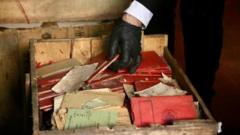In a fascinating turn of events, crates filled with documents from Nazi Germany have been found in the basement of Argentina's Supreme Court, where they had languished for decades. This remarkable discovery occurred during a routine clearing of the building's archives in preparation for the establishment of a new museum.
Court personnel reported that these documents were shipped by the German embassy in Tokyo and arrived in Argentina on June 20, 1941, contained within 83 diplomatic pouches on a Japanese steamship. Argentine customs officials had intercepted the shipment the same year, suspecting it of containing materials that could undermine the country's neutrality during World War II. Upon inspecting five of the pouches, they discovered a trove of Nazi propaganda that led to the seizing of all 83 pouches.
The wooden crates were unearthed last week by archivists who were intrigued by the appearance of vintage champagne crates. Once opened, they revealed materials designed to further Adolf Hitler's ideology in Argentina during a tumultuous period. The Supreme Court subsequently secured these items and collaborated with the Buenos Aires Holocaust Museum to document their contents.
Among the documents are black-and-white photographs and membership booklets adorned with swastikas, prompting historians to investigate potential insights into Nazi financial networks and international affiliations. The Supreme Court shared its findings, explaining that the shipment was initially declared as "personal effects" by the German embassy, but customs officials raised concerns over the large volume of materials.
Despite a request from the German embassy to return the pouches to Tokyo, an Argentine judge ordered their seizure in September 1941. With no decisive action taken by the court until 1944—after the country severed ties with the Axis powers—the crates ended up forgotten, gathering dust in the court's basement for years.
Post-World War II, Argentina under Juan Perón became a sanctuary for numerous high-ranking Nazi officials, including infamous figures like Adolf Eichmann and Josef Mengele. In acknowledging this dark chapter, President Fernando de la Rúa issued an official apology in 2000 for Argentina's role in providing refuge to war criminals, a reflection of the nation’s complex legacy. The recent discovery of these documents may shine new light on that historical narrative, as historians strive to uncover more about Nazi influences even after the war ended.
Court personnel reported that these documents were shipped by the German embassy in Tokyo and arrived in Argentina on June 20, 1941, contained within 83 diplomatic pouches on a Japanese steamship. Argentine customs officials had intercepted the shipment the same year, suspecting it of containing materials that could undermine the country's neutrality during World War II. Upon inspecting five of the pouches, they discovered a trove of Nazi propaganda that led to the seizing of all 83 pouches.
The wooden crates were unearthed last week by archivists who were intrigued by the appearance of vintage champagne crates. Once opened, they revealed materials designed to further Adolf Hitler's ideology in Argentina during a tumultuous period. The Supreme Court subsequently secured these items and collaborated with the Buenos Aires Holocaust Museum to document their contents.
Among the documents are black-and-white photographs and membership booklets adorned with swastikas, prompting historians to investigate potential insights into Nazi financial networks and international affiliations. The Supreme Court shared its findings, explaining that the shipment was initially declared as "personal effects" by the German embassy, but customs officials raised concerns over the large volume of materials.
Despite a request from the German embassy to return the pouches to Tokyo, an Argentine judge ordered their seizure in September 1941. With no decisive action taken by the court until 1944—after the country severed ties with the Axis powers—the crates ended up forgotten, gathering dust in the court's basement for years.
Post-World War II, Argentina under Juan Perón became a sanctuary for numerous high-ranking Nazi officials, including infamous figures like Adolf Eichmann and Josef Mengele. In acknowledging this dark chapter, President Fernando de la Rúa issued an official apology in 2000 for Argentina's role in providing refuge to war criminals, a reflection of the nation’s complex legacy. The recent discovery of these documents may shine new light on that historical narrative, as historians strive to uncover more about Nazi influences even after the war ended.


















